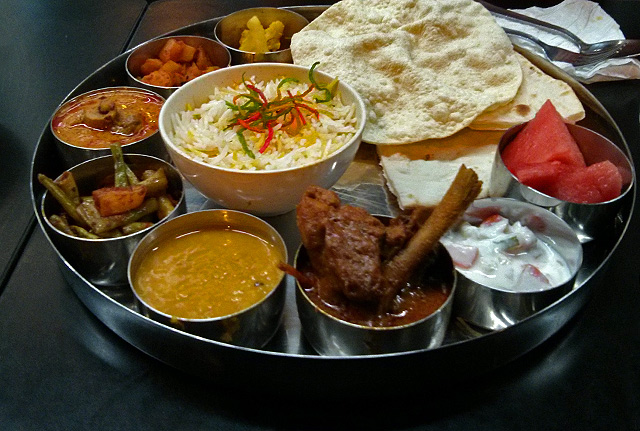The food supplied in the athlete's village at the Commonwealth Games needs to cater to a diversity of sports, cultures, ages and special dietary needs. Here is some information about the village and food menu for the Commonwealth Games Delhi in 2010. See more about Commonwealth Games nutrition.
About the Village and Food Hall
The Athlete Village was built to accommodate up to 8500 athletes and support staff, and the dining hall was designed to seat approximately 2216 athletes and officials at any one time, representing 71 countries. The kitchen, spread over 3,000 sqm, will run 24 hours a day and is expected to reach a peak level of 30,000 meals daily during the Games. There will also be a separate area allocated in the dining hall to feed approximately 700 staff. Also, packaged foods will be available for volunteers, workforce and security personnel at a cost of Rs.120 for breakfast, lunch and dinner.
Food Hall Menu
There was a lot of controversy about the state of the athlete village in the lead-up to the Games, issues that were mostly overcome by the start of the event. Hopefully, the poor level of cleanliness of the accommodation was not reflected in the dining area. In a country that is well known for poor food hygiene (beware of 'Delhi Belly'), it will be a challenge to provide a range of good quality food and maintain the health of the athletes.
As for previous Commonwealth Games, the athlete village menu in New Delhi has to cater to a wide range of sports, cultures, ages and special dietary needs. The provision of food for the athlete village was a collaborative effort by Delaware North of Australia and Indian caterers TajSATS. The dining hall will be open 24 hours a day and broken into meal periods of breakfast, lunch, dinner, and supper (overnight). There will be a six-day cyclic menu with a range of items offered all day. Below is a description of part of the menu to be found at the village food hall.
- Six 6 types of yogurt like soya, natural fat, greek etc.
- Eight kinds of fresh herbs like basil, parsley, oregano and tarragon.
- One type of smoked fish like smoked salmon.
- Six kinds of deli cold cuts like smoked chicken breast, buffalo salami and chicken ham etc.
- Up to 12 vegetable crudités like zucchini, celery etc.
- Six types of fresh whole fruits like orange, banana, mango, apple etc.
- Up to twelve types of assorted cheese including cheddar, Danish blue, sponge etc.
- Four types of grilled meats like chicken steak, chicken cutlets etc.
- Four types of assorted nuts; cashew, peanuts, almonds etc.
- Up to 30 kinds of salad bars like lettuce, cherry tomato, artichoke, beetroot, cucumber etc.
- Eight types of fruit juices including watermelon, pineapple, mango etc.
- Four specialty oils like extra virgin, walnut sesame, hazelnut etc.
- Six dry cereals like cornflakes, wheat barn, wheat flakes etc.
This is an extensive food list, however, you should notice that it does not include any beef or beef products at all (with respect to India's reverence for cows). You will not find beef anywhere in the dining area, as well as there will also be 'no-pork' zone, where food will be available to people from countries that ban the ingestion of pork due to religious reasons. Athletes will also find coffee and soft drink (soda) vending machines (Coca-Cola was an official Commonwealth Games sponsor).
 A sample of typical Indian food
A sample of typical Indian foodAs with the menu at previous Commonwealth Games, there is a focus on local cuisine. India's street foods such as pani puree, papri chat and bhel puri will have a special stall in the middle of the main dinning hall, and other Commonwealth Games country's street food will be served in a casual dining area with a 'fun, alfresco environment'. Of course, there will be a Village Bar that will serve liquor and wine.
Food labels will be written in English only, with a color coding system to indicate vegetarian dishes (green), and those containing red meat (red) and pork (burgundy). There will also be energy and macronutrient breakdown per serve and per 100g, and labeling for vegan, seafood, spicy, high carbohydrate and low-fat meals. There will be a nutrition kiosk manned by dietitians where any athlete that has a special dietary request will be sent for assessment and advice.
Related Research
- Burkhart SJ, Pelly FE. Athletes' opinions of food provision at the 2010 Delhi Commonwealth Games: the influence of culture and sport. Int J Sport Nutr Exerc Metab. 2013 Feb;23(1):11-23.
- Burkhart SJ, Pelly FE. Beyond sports nutrition: the diverse role of dietitians at the Delhi 2010 Commonwealth Games. J Hum Nutr Diet. 2014 Dec;27(6):639-47.
- Pelly FE, Burkhart SJ. Dietary regimens of athletes competing at the Delhi 2010 Commonwealth Games. Int J Sport Nutr Exerc Metab. 2014 Feb;24(1):28-36.
Related Pages
- See more about Commonwealth Games nutrition.
- Olympic Village nutrition, includes links to info about the menu at Olympic Games events.
- Nutrition at the Olympics — athlete diets throughout the ages.
- About the Commonwealth Games Delhi in 2010
- About the Commonwealth Games
- Food Safety Information
- Nutrition for Athletes at Major Events


 Current Events
Current Events